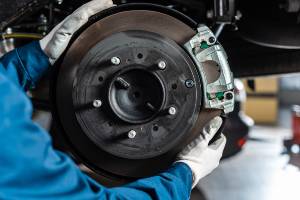Blog
How Car Parts May Put Mechanics and Others at Risk for Asbestos Exposure
Posted on behalf of Peter T. Nicholl in Mesothelioma & Asbestos Published on March 9, 2021 and updated on March 15, 2022. If you work as an auto mechanic or another position in the automotive industry that requires you to be around older vehicles, you could be at risk for inhaling asbestos fibers. Many older automotive products, and even some newer ones, contain asbestos.
If you work as an auto mechanic or another position in the automotive industry that requires you to be around older vehicles, you could be at risk for inhaling asbestos fibers. Many older automotive products, and even some newer ones, contain asbestos.
If asbestos is disturbed, fibers could be released into the air and breathed in by anyone nearby. While there is no safe level of exposure, if you breathe in asbestos fibers on a regular basis, it could lead to life-threatening health issues, such as asbestosis, mesothelioma or lung cancer.
Below, learn more about automotive products that may contain asbestos and how workers and others could be exposed because of it.
If you have questions about your legal options after being diagnosed with an asbestos-related disease, call the Law Offices of Peter T. Nicholl to schedule a free consultation. Our Maryland mesothelioma lawyers have helped numerous asbestos victims secure compensation for medical treatment and other damages.
Asbestos in Car Parts
When you learn more about the properties of asbestos, it is easy to see why it was used across numerous industries. Asbestos is a durable material that is resistant to heat and helps make things fireproof. This is particularly important for car parts, as car engines generate a lot of heat and there is a lot of friction.
There are numerous car parts that may contain asbestos, such as:
- Insulation
- Housing for air conditioning
- Spark plugs
- Brakes (brake pads, shoes and lining)
- Gaskets
- Clutches
- Hood liner sheets
- Valves
- Heat seals
- Packing
- Mufflers
- Muffler repair compound
- Soundproofing
- Undercoating
- Body filler compound
- Floor insulation
- Firewall insulation
- Woven asbestos backing
- Decal stripes
- And more
Who is at Risk for Exposure from Car Parts?
Anyone involved in the building and repair of cars could potentially be exposed to asbestos from these asbestos-containing materials. The danger comes when asbestos fibers are disturbed, which could occur when components are moved around or put together.
Even those who are not working directly with asbestos could be exposed when fibers become airborne. It often takes a day or two for asbestos fibers to settle to the ground once they have been disturbed.
Asbestos fibers can also settle on hair, clothes or skin. Workers could bring these fibers home and they could be breathed in by others they live with or come into contact with.
Auto mechanics who repair or install brakes have a particularly high risk of asbestos exposure.
Others who may be at high risk for asbestos exposure from car parts include:
- Bus drivers
- Construction workers who work on roads
- Technicians who service diesel engines
- Railroad workers (conductors, repair people and others who work on or around trains and railroads)
- Operators of heavy machinery
- Toll operators
- Truckers
- Gas station workers
- Auto body workers and repair people
- Assembly line workers
How Can Automotive Workers Stay Safe?
There are some mitigation strategies automotive workers may be able to use to reduce their risk of asbestos exposure.
For example, the Occupational Safety and Health Administration sets regulations for brake and clutch inspection, repair and assembly, such as the wet wipe method. This involves the use of a spray bottle to shoot a fine mist at a low pressure on brakes and clutches. Workers can then use a cloth to wipe brakes and clutches clean. This should be used for shops that do less than five brake or clutch jobs in a week.
There is also the negative-pressure enclosure method. Workers use a box with clear plastic walls around the brake or clutch. This is meant to contain asbestos dust and prevent it from being released into the air. This method should be used in shops that do more than five brake or clutch jobs in a week.
Some of the most hazardous techniques for cleaning brakes and clutches that put workers at high risk for asbestos exposure include:
- Using a shop vacuum cleaner because it is not fine enough to catch asbestos fibers
- Brushing dust off an assembly
- Using compressed air hoses to clean drum brakes
- Removing dust with a water hose
Schedule a Free Legal Consultation
The Law Offices of Peter T. Nicholl has secured millions in compensation for victims of asbestos-related diseases. We have taken on large corporations and won large verdicts for numerous clients.
We know how important compensation can be while asbestos victims go through medical treatment and cope with the many other issues that come up.
The initial consultation with one of our licensed attorneys is free of charge. There is also no obligation to take legal action if you have a case. We are only paid if you receive compensation.
Injured and need legal help? Free Consultation. Call our firm today: 410-907-3957.

